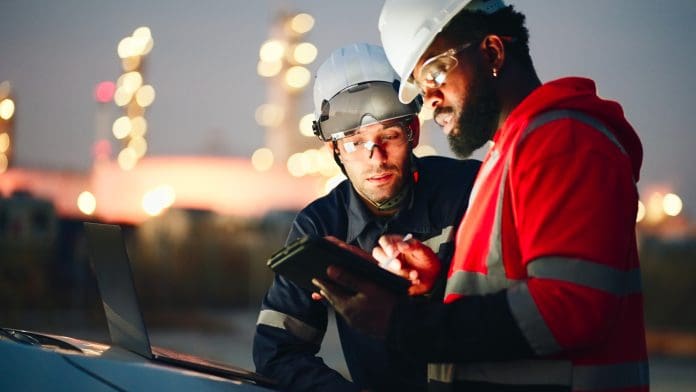Virgin Media O2 Business’ Andres Cruz Gordon explores the positive impacts of connecting built environment field workers with mobile solutions
As the digital transformation of workflows accelerates, the built environment landscape is changing. Cloud-based tools, video conferencing platforms, and real-time collaboration software have replaced traditional paper-based processes for field worker communications.
However, unlike the controlled environments of office settings, construction sites are dynamic, and reliable connectivity can be hard to guarantee through traditional connectivity solutions. As mobile networks evolve and innovative solutions emerge, the benefits for construction professionals such as site managers, architects and contractors are far-reaching. By embracing the latest technologies and adopting a forward-thinking approach, field workers within the built environment can pave the way for more automated workflows and better service delivery, unlocking greater efficiencies, improving safety, and driving stronger industry collaboration.
A toolbox fit for the mobile workforce
Field workers in construction need the right tools. Imagine a construction worker on a remote site who is able to access Building Information Modelling (BIM) systems and schematics in real time via a tablet or smartphone. Instead of relying on physical blueprints, construction professionals can instantly retrieve the most up-to-date information, saving not only time but reducing costly errors that may arise when working from outdated plans. The latest research on the use of mobile devices in construction shows that they could raise productivity margins by 15% within the next decade, reducing project costs and increasing return on investment.
Remote monitored Internet of Things (IoT) sensors can also reduce the need for field workers to travel long distances. Delivering data from IoT-enabled sensors can enable real-time updates from the construction site reflecting the actual progress made and conditions worked in. Site wide wireless connectivity can enable field force communication and enhance interactions between team members from and to almost any location, whether on handheld devices or wearables such as smart helmets. A combination of location tracking, body cameras, and CCTV powered by computer vision, can help monitor and analyse worker locations, health & safety at work, movements and activities.
While these tools are transformative, they rely on one critical component – robust connectivity – for which 4G and 5G-enabled private networks are the backbone. Lower latency mobile connectivity and higher bandwidth speeds are opening up completely new ways of working.
In urban areas, high-speed mobile networks ensure that field workers can stay connected even in the most congested environments. For rural or remote construction sites, this must be replicated, and advanced solutions like portable network hubs are key to improving efficiencies across projects.
Collaboration in the cloud
Connectivity also extends beyond the physical site. Cloud-based collaboration tools allow field workers to interact seamlessly with colleagues, whether they’re in the office or on another site. Platforms that integrate video conferencing, document sharing, and project management ensure that everyone remains on the same page, irrespective of their location.
For the pop-up or temporary office needs of a construction site, SD-WAN can be invaluable. With its ability to optimise network performance, enhance security and provide greater flexibility, SD-WAN can help people get the most from their network. Routing network traffic dynamically and securely over multiple connections to the cloud, it’s ideal for workers spread out remotely over multiple sites, so that they can benefit from enhanced application performance and greater operational resilience.
Alternatively, for those in rural or remote areas where there is no traditional fibre connection, Satellite backhaul technology can be used to enhance mobile coverage, ensuring field workers stay connected in even the most challenging locations. This provides reliable communication and boosts both productivity and safety for those working in the field.
The human impact
While technology is a key enabler for reducing administrative burdens and optimising workflows, it’s important not to overlook the human benefits of allowing field workers in construction to focus on what they do best: build, create, and solve problems. Happier, safer and more efficient workers lead to better outcomes—not just for individual projects, but for entire organisations.
Our recent research with the Centre for Economics & Business (Cebr) highlights how effective digital investment can create opportunity for businesses to expand their headcount. If all UK organisations had increased their use of digital between 2021 and 2023, 676,000 new jobs could have been created across sectors, with all businesses seeing a 2.2% employee uplift and medium sized businesses seeing the biggest increase of 3.3%.
In construction, this would enable decision makers to invest the required skilled labour to deliver projects faster and with greater precision. By freeing up resource elsewhere through digital efficiencies, they can also reinvest savings into training new talent, scaling their operations and taking on more ambitious projects. This workforce expansion also brings with it a critical responsibility. Technology plays a fundamental role in the duty of care to keep workers safe – businesses operating across the built environment sector should avoid making the mistake of thinking that the future of work only applies to knowledge or office-based workers.
Wearable devices connected via mobile networks are increasingly being used to enhance worker safety on construction sites. Smart helmets equipped with sensors can monitor vital signs, detect falls, or alert workers to hazardous conditions in real time. Yet, this level of safety and responsiveness simply can’t be possible without having the reliable connectivity foundations in place.
A connected future for field site workers
The potential to create smarter, more efficient worksites is within reach. The challenge now is for decision makers within the built environment to embrace these opportunities and invest in the tools that will enable their workforces to thrive in an increasingly connected world.
For field workers, the shift to digital workflows isn’t just a technological upgrade—it’s a transformation that empowers them to work smarter, be safer and operate more effectively. And for the built environment industry overall, it’s a chance to build a future where connectivity isn’t just a convenience, but the bedrock of success.















I completely agree that mobile solutions are crucial for field workers. They enhance communication and efficiency, making it easier to handle tasks remotely. It’s about time we prioritize their connectivity!